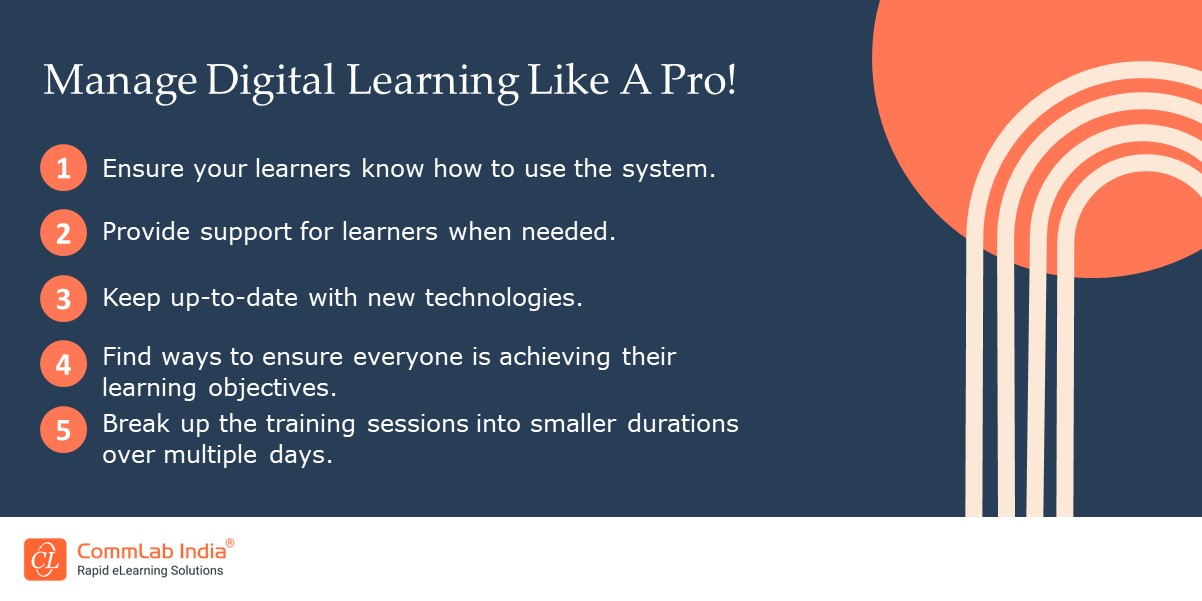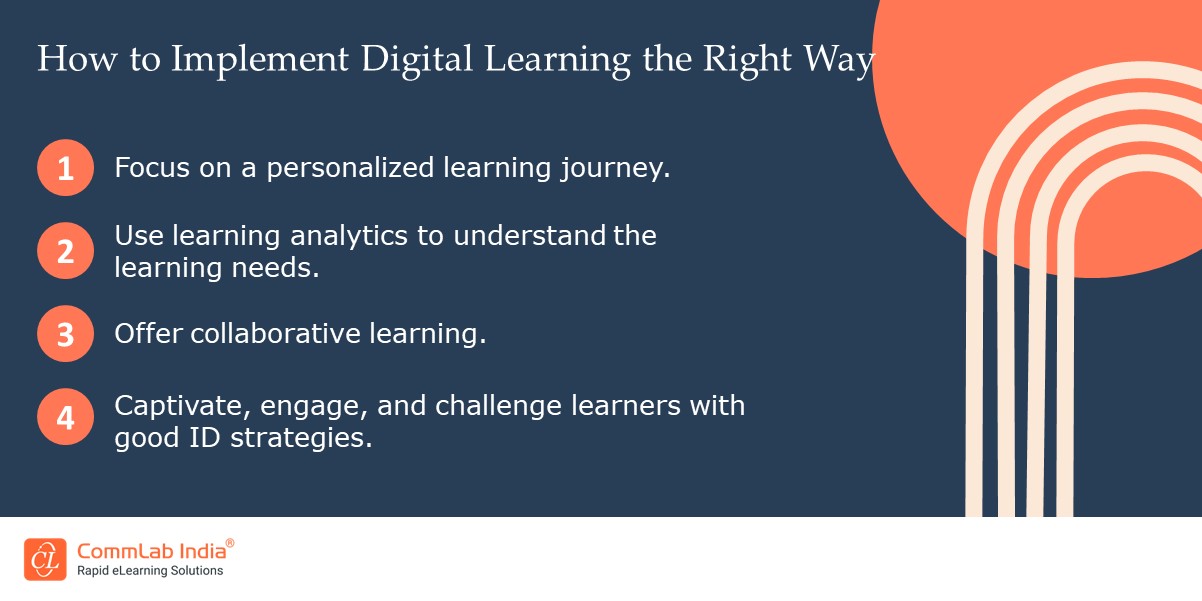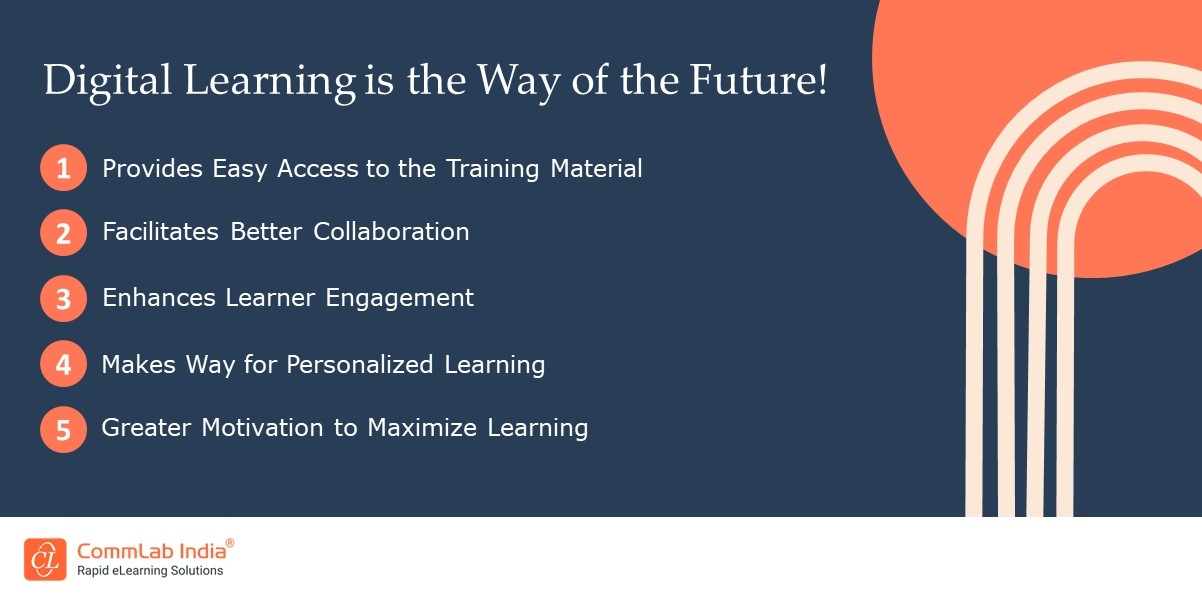Introducing Digital Learning
While the world was picking up pace in adopting digital technologies in every way possible, the Covid-19 pandemic jumped in as a catalyst and took the digital transformation to a whole new level. Going digital went from being an opportunity to grow to being a necessity for survival! And the L&D industry responded to this by accelerating technology adoption within the industry.
And the result? It can be well felt in the increased adoption of digital learning, VILT, microlearning, gamification, and blended learning.
Let us try to understand all about digital learning and how to leverage it to deliver corporate training.
What is Digital Learning?
Digital Learning, which falls under the umbrella of Online Learning, has gained a lot of popularity since the pandemic. However, this method has been in use since the early 2000s. digital learning can be defined as “any type of learning that uses digital tools and technologies”.
A subset of online learning, digital learning involves the application of several practices including adaptive learning, virtual training, blended learning, mobile learning, and personalized learning.
The terms eLearning and digital learning are often used interchangeably. However, eLearning is just one modality of digital learning. On the other hand, digital learning encompasses all online learning methods.
Simply put, digital learning refers to the digitalization of the whole learning experience and it includes social learning, virtual discussions, online assessments, professionalization workshops, etc.
What Digital Learning is Not?
There is a common misconception that digital learning is about digitizing learning content. But that’s far from the truth! Digital learning involves using tools and techniques to digitalize the whole learning experience. It uses technology at each learning step – instruction, learning materials, evaluations, and analytics. Therefore, digital learning is not just the use of digital devices, its use of technology goes much beyond. Simply put:
- Digital learning is not just the digitalization of content.
- Digital learning is not just the use of digital devices.
Digital Learning — The New Normal
The question arises “Why Digital Learning?” Let’s find out!
Accessibility
With remote working becoming the new normal, L&D professionals have been focusing on ways to make corporate training more accessible. Enter Digital learning!
Digital learning uses technology in every aspect of the learning journey. This includes the mode of instruction, the availability of the learning materials, and tracking and analyzing the progress. And the use of technology makes learning more accessible – it is made available anywhere and anytime.
Affordability
Affordability has always been one of the major concerns for L&D professionals. Digital learning addresses this very concern. How? You ask!
With digital learning, the time and costs of transportation, infrastructure, and the cost of upgrading digital materials significantly decrease. The hours saved can be utilized productively. This way, digital learning is not just affordable but also offers improved ROI.
Adaptability
Handling their job and focusing on learning and development can be a little difficult for employees. Managing both can be much easier when the learning is made more flexible. Thanks to digital learning for offering this very adaptability!
With digital learning, learning is not only available whenever required, but the learner is also able to decide the pace of their learning and revise as and when required. This adaptability makes learning more efficient.
Preferred Digital Learning Formats
Here Are a Few Popular Digital Learning Formats
- Microlearning
- Mobile Learning
- Gamification
- Simulation
- Video-based Modules
- Virtual Instructor-led Training
There are several formats that can be used to impart digital learning. Some of the most engaging formats include:
Microlearning |
Microlearning is a digital learning format that involves delivering information in bite-sized digestible learning modules where each module focuses on a single learning objective. This way, the employees can learn at their convenience. |
Mobile Learning |
Mobile learning is accessible and flexible, and L&D professionals can leverage the same to deliver training modules that can be accessed with ease at any place, any time using any device. |
Gamification |
Gamification is utilizing game elements and interactivities for training and learning. It helps make learning fun, engaging, and interactive for learners. Learners are motivated due to a healthy competitive learning environment. |
Simulations |
The use of simulations is another engaging way to impart training. Simulations provide learners with an opportunity to practice real-life scenarios in a risk-free environment. This provides learners with hands-on experience on the subject. |
Video-based Modules |
Videos serve as powerful mediums to impart eLearning and capture the learners’ attention to the subject being discussed. To deliver corporate training, videos – both animated ones or the ones with an instructor explaining the concepts – can be used. Video-based learning can also be made more engaging via the use of attractive visuals, voiceovers, and animations to break down complex subjects into immersive nuggets. |
Virtual Instructor-led Training |
Virtual classroom or virtual instructor-led training(VILT) is a popular digital learning format in which the instructors deliver training using different tools including video conferencing, video recording, digital whiteboards, chats, and participation controls, to interact with the learners in real-time. |

Digital Learning Trends to Watch Out For
1. Artificial Intelligence
Every activity that is automated to reduce human effort is done through different aspects of artificial intelligence. Almost every machine we use today has some or all of its functioning based on the 4 areas of AI, i.e. machine learning, deep learning, natural language processing, and computer vision. AI makes it easy for machines to perform various daily life tasks of humans with great accuracy. Some examples of AI are self-driving cars, automatic language translations, speech and face recognition, cloud computing, and chatbots.
Incorporating artificial intelligence is extremely crucial for learning & development pros as it helps them to automate a lot of time-taking tasks efficiently. Some of the major uses are eLearning translations, content generation, personalized reports, and customer support. Almost all modern authoring tools and learning management systems utilize the power of AI to provide multiple advanced features to developers so that they can design interactive and engaging digital learning courses.
2. Augmented Reality & Virtual Reality
AR (Augmented Reality) uses the real-world environment and connects it with virtual objects whereas VR (Virtual Reality) is an entirely separate fictional reality. The users do not need any specific device to play around with AR but there is a need for an individual system and a headset to get immersed in the VR environment. In the corporate training domain too, AR and VR are extremely useful to help employees in the medical department, manufacturing factories, and technical training to create immersive simulations where the learners can interact with the objects risk-free in real-time.
3. Metaverse
Metaverse started as a cool concept in video games but eventually got introduced to the real world, all thanks to the constantly evolving technologies every day. Metaverse is based on blockchain technology incorporated with the applications of mixed real concepts. In simple words, the real world is replicated virtually in the metaverse, where all the real-time actions will affect the virtual environment. AR and VR work really well with the metaverse and help the users to get entirely immersed in the virtual environment.
In the eLearning industry, metaverse can completely transform the way we train and the work culture, employees would be able to attend their offices while at home. They can also make transactions with the help of cryptocurrencies, attend virtual events, and have their individual unique identity through NFTs.
Digital Learning for Various Types of Training
1. Product Training
In this digital era, there are numerous products getting launched every day, and it’s really challenging for the employees of the respective organizations to be up to date with all the features of all their products. And as we are aware the modern workforce is pretty tech savvy; hence digital learning can be one of the best solutions to get the best results out of their product training sessions. Considering a basic product has 3 common aspects, its features, theoretical knowledge, and practical expertise, there can be multiple digital learning formats that can be highly effective.
Various learning formats like microlearning, gamification, quizzes, interactivities, etc. can play an important role during product training. Digital learning can make product training more engaging, immersive, and easy to update, ensuring that the employees are updated on all the upcoming and existing products.
2. Technical Training
Everything in this world is already on its way to getting digitalized, hence it is crucial to provide your employees with relevant technical training. The technical expertise of at least a beginner level is now a need rather than a desire in this modern world. Whether it is a simple billing machine or a complex machinery controller, all the employees should know how to operate various technical machines or software tools. Digital learning is arguably the most convenient training format to provide effective technical training for the multiple software tools your employees might have to use daily at their job.
Organizations can make use of digital learning formats to ensure effective learning. Microlearning videos or content slides are an ideal way to train employees for beginner-level training. Introducing a social learning forum where the developers can share codes or their issues and get help from other developers is also a good idea. It allows employees to learn better together.
3. Environment, Health, and Safety Training
Your workplace can be a manufacturing industry, a corporate office, a shopping mall, a hospital, etc. whatever the type of workplace you have the employees must be given environment, health, and safety training. Employees need to understand their work environment in detail to work productively while maintaining their health, both physical and mental. Digital learning is a good option to train employees on the environment, health, and safety.
Learning can be made engaging and interesting by incorporating various gamified assessments, and employees can also attend various podcasts, webinars, or online workshops to gain critical insights about maintaining their health and safety at the workplace. For more complex and detailed training virtual simulation is an ideal solution where employees can get a hands-on experience with real-life scenarios in a risk-free environment.
4. Employee Onboarding
When a new employee is hired, it is extremely tough for the individual to get used to a whole new environment and feel confident at work. Only basic compliance training is not the solution, their onboarding needs to have multiple layers to be effective. Digital learning helps the employee have a successful onboarding because of the variety of issues it solves. The most important problem lies with remote employee onboarding, and that becomes seamless with the help of digital learning. When the employees receive an interactive and personalized onboarding experience, they tend to become confident and productive in less time, enhancing the training ROI for the organizations.
Digital learning saves a lot of time, money, and effort for organizations, as employees can access their training on the go. Apps like Trello and Whatfix can track their daily deliverables and facilitate self-paced training. Learning analytics can be effectively used to generate personalized reports of the employees, and thus their performance can be tracked, and organizations can work on their employee’s requirements individually.
5. Sales Training
Given the nature of their job, the sales personnel are always on the go. What they need is training that can be accessed remotely whenever they want. Thanks to digital learning it is possible. Digital learning courses can be made accessible offline, whether they are external resources, product videos, infographics, and image slides as a digital manual, or an audio clip of their sales pitch, for quick knowledge retention. The training modules made especially for the sales team are advised to have a mobile-first design as it is difficult to carry a system everywhere.
Organizations can also make use of scenario-based learning giving employees an opportunity to practice some real-life situations in a risk-free environment. Based on that employees can also be provided with various gamified assessments like polls and quizzes either in the middle of their course or post-course, to ensure knowledge retention.
6. Soft Skills Training
When digital learning is so impactful for technical training, why should soft skills training be left out, after all, they are equally important for an employee to be productive in this competitive environment? The major soft skills that are crucial for corporate employees are communication, teamwork, leadership, time management, critical thinking/decision-making, and emotional intelligence. There are more but their relevance is very specific to an employee’s job profile and digital learning is a great solution to provide impactful and engaging soft skills training for corporate employees.
Creating microlearning assets for on-the-job training and performance support can help them gain these soft skills over time, and help them with information retention. Virtual classrooms are also a viable option for employees to interact with their peers and learn from each other. Employees can connect socially through social media platforms or online forums. Online workshops can also be of great help in improving this skill.

Roadmap for Successful Implementation of Digital Learning
1. What you need
Understand the need for digital learning:
Implement digital learning only when you have ensured it will solve your various problems. Every industry has its own set of issues to tackle, so if digital learning sounds like a solution for your organizational issues, then go for it.
Pre-allocate the training budget:
Digital learning saves a lot of time and money, but it costs a bit to get started as well. Make sure your organization has set a pre-allocated budget to start the implementation. Consider the aspects like the type of your target audience, the average number of trainees, and a separate team to manage learning and development queries.
2. Key decisions to be taken
Whether to develop in-house or outsource the process:
If you have a well-structured team that has the expertise to develop engaging and interactive digital learning modules then go for in-house development. But if you lack any of the various requirements, it’s best to opt for outsourcing. You can either outsource selective aspects like eLearning translations and instructional design, or you can just outsource everything A-Z to save yourself from the hassle. And who could be the trusted partner? The answer is CommLab India!
What design and development strategies to follow:
Once you have decided to outsource or not, you need to decide how your course looks and proceeds. There are different types of learners, and your learning analytics report will help you figure out what suits your learners the most, and then decide the perfect instructional design strategy.
How to increase awareness within the organization
Everyone in the organization needs to be on the same page so that things run smoothly. It’s important to decide how the L&D teams will make everyone in the organization aware of the importance of adapting to digital learning by discussing its various benefits.
3. Infrastructure requirements
- When it comes to infrastructure, there are a few basic requirements like stable internet, device availability, constant electricity in the workplace, network security, and other hardware are mandatory.
- Organizations should also provide a help desk for all sorts of technical support for the employees so that their issues can be resolved as soon as possible without disrupting the workflow.
4. How to convince your key stakeholders
Explain to the Stakeholders About its Impact:
Business leaders come forward to make an investment only when they know that the step guarantees high returns. So, in order to convince them to invest in digital learning, the first step would be to highlight its benefits and how it will have a positive impact on the business.
Identify the Points Causing the Resistance:
If the stakeholders are against the plan, then it is important to identify the reasons holding them back and these reasons should be addressed and eliminated. They should be explained how digital learning could be eliminating their problems.
Make use of real-time examples:
Case studies highlighting the benefits, ROI, increase in employee productivity, and business profits can make an excellent case.

Best Practices for Digital Learning
Tips For Successful Digital Learning
- Always Focus on Accessibility.
- Aim to Develop a Connection with Your Learners.
- Ensure Collaboration, Make Use of Collaborative Tools.
Here are a few best practices/ tips that would add value and take digital learning initiatives to the peak:
Focus on accessibility
Accessibility is among the three pillars on which digital learning is based. Considering this, it is crucial that the solutions created are accessible to all the stakeholders involved including the SMEs, instructors, employees, and learning managers. The solutions should be accessible with respect to availability, and usability irrespective of the users’ demographics.
Develop a connection with the learners
Digital learning means that your employees wouldn’t have to spend a lot of time inside a classroom. Most of the learning and training happens through online mediums. Because there is comparatively less human interaction, it is important to make a connection with the learners and build a learning culture within the organization. The course objectives and goals, delivery mediums, level of interactivity, and everything can be planned accordingly.
Ensure collaboration
As discussed earlier, human interaction is less in an online learning environment. The use of collaborative tools can address this concern. There are several tools that help the eLearning stakeholders collaborate and interact. Collaborative platforms such as Articulate 360 or Miro serve the purpose as the enable conversations, sharing feedback, content library, etc.


